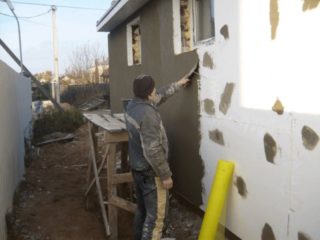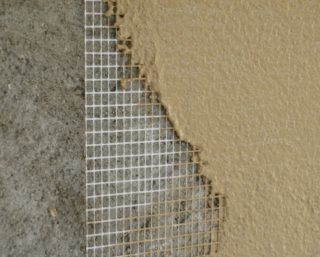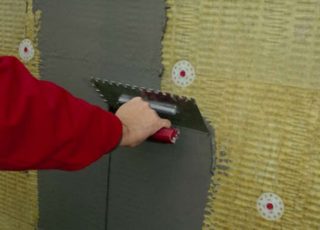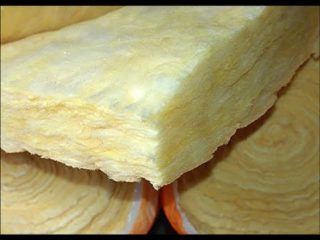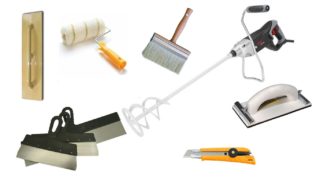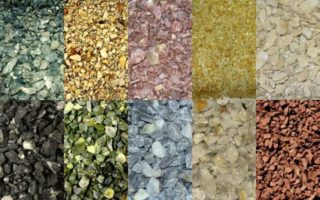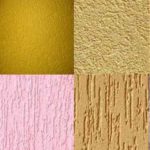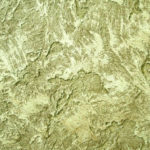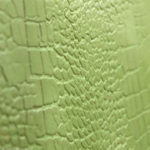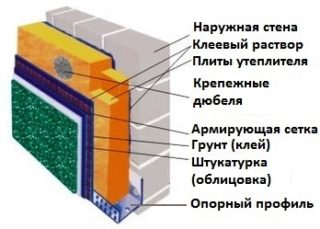An effective way to maintain a comfortable microclimate in the home is to plaster the facade with insulation. The protective material without external decoration has an ugly appearance and is destroyed under the influence of precipitation and temperature changes. Plaster layers are of various types, differ in properties and technical characteristics.
Technology benefits
The facade forms an impression of the architectural style of the building and refers to the exponential part of the house. Exterior walls for insulation protects the home from the effects of wind, moisture, rainfall compared with internal thermal insulation. Facade plastering moves the condensation point to the outer surface, and moisture evaporates in the atmosphere, and not inside the room.
External cladding reduces the risk of cracks in the load-bearing wall and extends the life of the building. Thin-layer finish improves the internal microclimate and increases the aesthetic perception of the structure. Visual defects are covered with decorative cladding.
Advantages and disadvantages
The plaster forms a protective layer, which stops the destruction of the insulation. Wet finish withstands temperature jumps, is not damaged by freezing.
The material has advantages when performing work on technology:
- not destroyed by mechanical stress;
- allows steam and condensation to escape;
- additionally protects against noise.
In passage places, a metal mesh frame is installed before plastering to prevent chips.
The process relates to laborious work and requires professionalism in application. Textured plaster takes extra time. The work depends on the air temperature (not lower than -5 ° C).
Choice of insulation
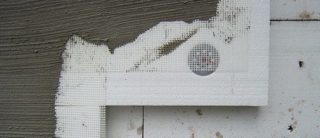
Material is sorted taking into account cost, durability, warming qualities.
The type of external wall is taken into account:
- for fences with low thermal conductivity (gas silicate, aerated concrete) mineral wool mats are used;
- porous walls (wood, coarse-grained slag or expanded clay concrete) need to be insulated with insulation with the possibility of air passage, for example, fiberglass with hydrophobic impregnations;
- for brick, concrete, a layer of foamed polymers is used.
The layer thickness depends on the type of material, this parameter affects the reduction in the cost of building insulation.
Expanded polystyrene
Lightweight boards are water resistant, they do not get wet under the influence of moisture and maintain integrity. The insulation layer does not let steam through, it is characterized by increased density. Penoplex contains fire-retardant flame retardants in the composition, so it self-extinguishes when ignited.
Negative qualities include:
- the release of harmful components when heated;
- destruction by the sun;
- damage from contact with bitumen and similar substances.
Extruded polystyrene foam, which is of high quality, works effectively for insulation.
Mineral wool
Thermal insulation for stucco made of mineral fibers serves for a long time.Mats have a different fiber structure, are resistant to heat, chemicals.
The material is available in 3 types:
- glass wool - from molten glass;
- stone wool is produced by melting sedimentary rocks;
- slag - melt residues of a blast furnace.
The vapor-permeable layer repels moisture well if there are hydrophobic additives in the composition. The material belongs to environmentally friendly species. For convenience, it is produced in two layers with a dense outer and loose inner surface.
Tools and equipment for work
To organize the automatic application of material to the facade, plaster aggregates or stations are used. The dry mixture is poured into the hopper, water is also supplied there. The solution is supplied to the surface by means of discharge hoses with a tip. The process uses rules, trowels, spatulas.
The technology of plastering on the facade insulation by the manual method is different and requires the use of tools:
- falcon for solution toe;
- bucket, spatula, spray scoop;
- trowel, trowel - distribution of the solution;
- grater - smoothing and grouting;
- level - quality control.
To align the internal and external corners, an angular trowel is used. The solution is prepared in special tubs made of metal or plastic.
Types of plaster
A distinctive feature of the finish is that the stucco on the insulation creates a uniform seamless coating on the entire surface of the wall. The technology does not require special fasteners that create cold bridges to weaken the thermal insulation qualities of the insulating layer.
Various application technologies are used to create an attractive decorative coating. Materials have various qualities.
Mineral
Cement, sand and active additives form the basis of the composition, pigments are introduced into the finished mixture during application. Mineral plasters are strong, but do not withstand the strong pressure of the liquid, for example, when washing the facade with liquid under pressure. Technological additives are used to reduce water permeability.
The material is packed in bags in the form of a dry mixture, which is diluted with water at the workplace. Mineral compounds are popular species due to the relative cheapness. Fungi and microorganisms do not multiply on the surface of the finish. The disadvantage is the small selection of colors.
Acrylic
The composition of the plaster contains mineral components based on acrylic polymer resins in the form of an aqueous solution. The surface layer has elasticity and serves a long time without loss of integrity. It requires regular cleaning, as Acrylic accumulates dirt and attracts dust.
The acrylic material for the decoration of the facade is sold ready-made in plastic containers. The coating refers to vapor-permeable types, so the wall gives off excess moisture to the atmosphere, there will be no dampness in the rooms. The additives in the composition protect against microorganisms.
Silicate
This material is between acrylic and mineral plasters. The basis of the composition is liquid glass or potassium silicate. Acrylic resins are added for flexibility. Mineral components in combination with fiberglass create a medium in strength and elasticity coating.
The mixture is sold in plastic containers and is ready for use. Advantages include high vapor permeability without the ability to retain moisture inside. The material does not accumulate static electricity, the final finish is carried out by coloring.
Silicone
The finishing layer creates a coating with high elasticity, while withstanding shrinkage of the building without collapsing. The silicone coating of the facade is self-cleaning during operation and does not attract dust. Dirt is removed during rain or wind.
The vapor permeability is low, but is at an acceptable level for partial removal of internal moisture. The disadvantages include the high price. The topcoat is made with polymer paints.
- Acrylic
- Silicate
- Silicone
Stages of plastering the facade with insulation
Facade plaster meets the declared qualities, if applied by technology. In the process, surface preparation is carried out, and for each stage, the drying time intervals are observed. So you can insulate the wall and in the future avoid regular repair of the facade.
Preparatory work
The area of the wall is cleaned of deposits, protruding mortar, irregularities get lost. Cracks on the surface deepen, wetted with a primer and filled with repair mortar. After drying, the surface is cleaned.
The total area of the facade is primed to increase adhesion to the insulation and create a protective film. Drying time is 24 hours.
Insulation Installation
The method of fixing the insulating layer depends on the type of insulation. For mineral mats, the installation of a frame of galvanized profile, which will support loose material, is required. Additionally, dowels with wide caps for wall mounting are used. OSB sheets are beaten along the frame for applying the plaster layer.
Plate insulation, for example, polystyrene, extruded polystyrene, is attached to the glue. The composition is applied to the back of the panel and pressed against the wall surface. Dowels – fungi are similarly used. The glue dries for 24 hours, after which the plaster is applied.
Facade reinforcement
The reinforcing gasket is placed on the surface to prevent cracking during operation. The layer is fixed in area using hardware, for example, of metal. If the pre-layer is thick, the mesh is recessed into it.
Plastic mesh is fixed with plaster. The edges of adjacent layers are at least 10 cm on top of each other. The layer is laid so that no wrinkles form. At the corners of the building and slopes of windows and doors, perforated corners made of galvanized or plastic are placed.
Plastering
The first layer (spray) of mineral plaster is applied with a trowel, then it is waiting for some time, and the primer layer is made with a liquid solution. Use a wide grater or putty knife. Coating is done on a hardened but moist surface that has not yet dried.
Silicate and silicone compositions are applied in 1 - 2 layers, while leveling is performed simultaneously, and the grout is done after solidification. Finally, the surface is painted in the selected color.
